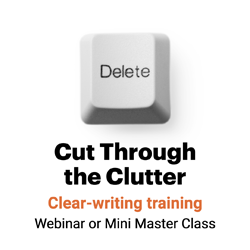Too many options paralyze people
Here’s a famous story among persuasion researchers and Malcolm Gladwell fans:

When a researcher offered shoppers 24 types of jam, many customers stopped by for a sample, but only 3% made a purchase. But when the researcher offered only six kinds, 30% of shoppers ended up buying jam.
“When people had too many choices, they just walked away,” says Sheena Iyengar, the researcher and author of The Art of Choosing.
Iyengar, a business professor at Columbia University, studies how people make decisions. When it comes to choice, her research shows again and again, less is almost always more.
Avoid overwhelming people.
People are also overwhelmed by the amount of information it takes to make decisions about:
401(k) plans. In a study for Vanguard, Iyengar found that for every 10 funds a company added to its options, the number of employees enrolling dropped by 2%. With two options, 75% of employees participated; when there were 59 funds, only 60% enrolled.
“If it’s a lot of work to choose among the funds, many people will postpone the decision and never sign up,” she says.
Medicare plans. When seniors had to choose a Medicare prescription drug benefit in 2006, they were overwhelmed by dozens of similar options. In the end, some 10% of seniors didn’t enroll by the deadline, even though it meant they’d have to pay extra to enroll late.
The problem, Iyengar says: “The program designers focused primarily on giving people quantity but not on quality.”
Health care plans. One of the most complex decisions we ask consumers to make is to choose among health insurance plans.
It’s not uncommon for consumers to have to compare more than 15 plans on each of 10 to 12 factors. And integrating different types of information and different types of variables makes decision-making even harder, according to researchers (Payne, Bettman and Johnson, 1993; Slovic, 1995).
Making matters worse, this information often:
- Includes technical terms and complex ideas
- Requires the reader to weigh factors based on their own values, preferences and needs
- Calls for readers to also consider coverage, benefits and costs
“More information doesn’t always improve decision-making; in fact, it can undermine it.”
— Judith H. Hibbard and Ellen Peters, researchers
For instance, if one hospital has high consumer satisfaction scores but average measures of safety and effectiveness, and another is highly effective but ranks low in satisfaction and safety, how do consumers weigh these factors in their choices?
What’s wrong with choice?
Making a choice takes three mental tasks, Iyengar says:
- Figuring out what you want
- Understanding the options
- Making trade-offs
This exercise becomes more complex as the choices multiply.
It would seem that the more information we give people, the better off they’d be.
But “having an abundance of information does not always translate into” informed choices, write researchers Judith H. Hibbard and Ellen Peters. “The amount of information may exceed human information processing skills.”
And when that happens, people shut down. They may simplify the decision by relying on others’ advice, by ignoring some of the information or by basing their decisions on the wrong things. Or they may not make a decision at all (Hibbard, Slovic and Jewett, 1997).
4 ways to reduce option overload.
So how can you make it easier for your readers to make a decision — instead of giving up and going home? Here are four ways to do that:
1. Reduce the number of options. People can keep track of five to nine choices, according to 60 years of brain research. Increase that to 20 or 30 options or more, and people become paralyzed or frustrated.
2. Think in decision layers. Try the three-by-three rule: Offer a matrix of three categories, each with three options. That’s nine options, but presented in a way that’s easier to think through.
Instead of deciding between nine options, readers make two decisions between three options each.
| 401(k) investment options | |
| High risk | Fund A Fund B Fund C |
| Medium risk | Fund D Fund E Fund F |
| Low risk | Fund G Fund H Fund I |
| Triple whammy A three-by-three matrix makes it easier for readers to decide. | |
3. Present information clearly. “How information is presented may be just as influential as what information is presented,” Hibbard and Peters write.
To help the reader understand:
- Reduce cognitive effort. Reduce the amount of information you present through decision-support tools, an information intermediary or visual displays of quantifiable information.
- Bring the experience to life. Show people what the decision will mean to them in real life through narratives, vivid details and tailoring.
- Reframe the data. Help readers see the significance of the information by highlighting, framing and otherwise presenting the data.
“Most presentations of comparative information are based on the assumption that consumers know what is important to them and where their self-interest lies,” Hibbard and Peters write. “These assumptions are faulty.”
4. Make it vivid. Show, don’t tell. Instead of asking how big a risk readers can tolerate, give them a picture of that risk.
Literally.
When Iyengar asked study participants whether they’d like a free ticket to see amazing scenery but with a steep drop-off from a cliff, 90% took the free ticket. But when she showed pictures of that steep drop-off, only 50% accepted the ticket.
“When there’s a vivid scenario — say, a picture of money leaving your wallet, not just a number — people understand the consequences better than when they are presented with abstract notion of risk,” Iyengar says. “Casinos know this, which is why they have you gamble with chips, not actual money.”
Other benefits of short form digital content
Short form digital content also makes messages easier to read, more efficient to read and easier to understand and remember. And it helps readers make better decisions.
How long should your content really be?
_____
Sources:
Judith H. Hibbard and Ellen Peters, “Supporting Informed Consumer Health Care Decisions: Data Presentation Approaches that Facilitate the Use of Information in Choice,” Annual Review of Public Health, 2003, Vol. 24, pp. 413-33
Penelope Wang, “How to make better investment choices,” Money, June 2, 2010

Leave a Reply